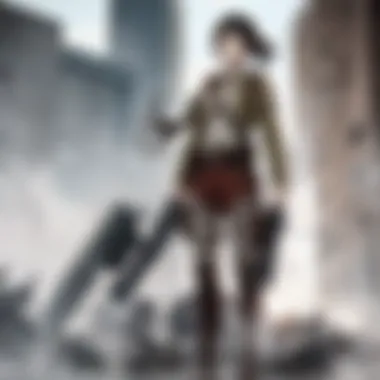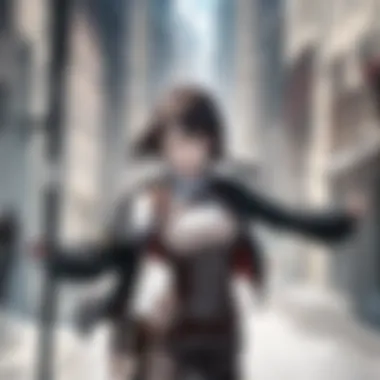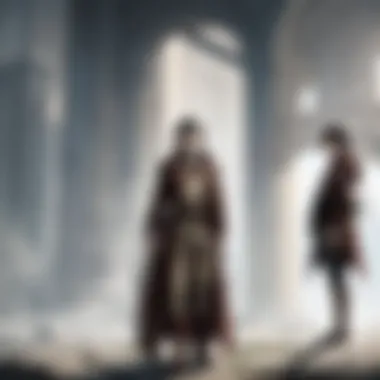A Deep Dive into Attack on Titan Season Four Episodes


Intro
The final season of Attack on Titan, an anime beloved by many, holds significant weight in how the narrative converges towards its conclusion. The fourth season diverges from previous arcs while maintaining the core essence of existential dread intertwined with compelling character arcs. This analysis aims to unpack the intricacies of each episode, their narrative significance, and how they resonate with the viewer's perception, contributing to the series’ enduring legacy.
Character Analysis
Overview of Character Development
In the fourth season, character development is profound and often brutal. Key figures such as Eren Yeager, Mikasa Ackerman, and Armin Arlert showcase transformations that reflect their inner struggles and the harsh realities surrounding them. Eren, once seen as a beacon of hope, adopts a darker, dystopian view of freedom, which leads to conflicting feelings among many viewers. Mikasa and Armin, though loyal friends, are forced to confront their values and principles in the light of Eren's drastic choices.
Each character’s journey is not just for personal growth; it becomes a representation of broader themes such as friendship, betrayal, and sacrifice. Characters evolve from idealistic warriors into complex beings shaped by difficult choices. This evolution resonates deeply, prompting viewers to reflect on their perceptions of morality and justice.
Key Relationships and Dynamics
The relationships in this season are intricate and filled with tension. Eren's growing estrangement from his closest friends creates a rift that lays bare the differing ideologies they embody. The relationship between Eren and Mikasa is particularly striking, showcasing a bond forged in childhood that becomes frayed as their choices diverge starkly.
Moreover, the introduction of Marleyan characters, such as Reiner Braun and Gabi Braun, adds layers to the narrative, offering perspectives that challenge the protagonists' viewpoints. Their interactions reveal a multi-faceted world where motives are not just black or white. This complexity invites the audience to reassess their allegiances in a story rife with shades of gray.
"The characters who once fought for their freedom face the bitter irony of becoming bound by their own convictions and relationships."
Thematic Exploration
Central Themes and Messages
The central themes of the fourth season revolve around freedom, the repercussions of violence, and the cyclical nature of hatred. Eren's radical choices serve as a stark commentary on the cost of freedom, illustrating that achieving one's ideals often involves sacrifices that contradict personal morals. The tension between freedom and security drives home the message that the pursuit of one can undermine the other.
The show also highlights the notion of history's implications on the present. Characters grapple with their legacies and the perseverance of conflict across generations, emphasizing that the sins of the past cannot easily be erased. These themes resonate profoundly, making the narrative not just an adventure but a philosophical inquiry into the human condition.
Cultural Context and Influences
The socio-political themes seen in Attack on Titan draw parallels with real-world historical events. The examination of power dynamics and the dehumanization of the ‘other’ mirror recurring historical narratives across various cultures. This season does remarkable work in reflecting these issues, encouraging viewers to draw connections between the fictional world and real-life struggles around identity, belonging, and conflict.
The impact of Attack on Titan extends beyond entertainment; it invites discourse on critical societal issues. This heightened examination of complex themes allows it to remain relevant in contemporary cultural discussions, making its contribution to the anime landscape significant.
By dissecting the episodes, we grasp how they end a journey filled with intricate storytelling and rich character landscapes. As the series culminates, it revives discussions on morality, society, and ultimately, what it means to be free.
Prologue to Attack on Titan
Understanding the backdrop of Attack on Titan is crucial for comprehending its final season. This series not only redefines narratives within the anime genre, but also impacts cultural constructs in its portrayal of conflict, freedom, and humanity. The detailed exploration of the show's premise provides insight into the emotional and thematic undercurrents that resonate with audiences globally.
With its intricate plot and character development, the final season required a foundation firmly laid by earlier episodes. Analyzing its introduction helps clarify key elements, setting the stage for an impactful conclusion. This section contributes significantly by highlighting the evolution of the series, leading to broader implications for viewers and the genre.
Overview of the series


Attack on Titan, adapted from Hajime Isayama's manga, debuted in 2013 and quickly gained recognition. The story unfolds in a world besieged by gigantic humanoid creatures known as Titans. The relentless pursuit of survival drives the narrative, focusing on Eren Yeager, Mikasa Ackerman, and Armin Arlert among others.
As battles ensue and human nature is scrutinized, the series tackles deep philosophical questions. The animation quality, coupled with a haunting score, enhances the viewing experience, drawing audiences into its complexities. Each season builds on the previous one, with the final season culminating in a quest for truth amidst chaos and betrayal. These elements are pivotal in shaping the audience’s engagement with the series.
Significance in the anime community
The importance of Attack on Titan extends beyond its plot. Since its inception, the series has reshaped discussions around storytelling in anime. It has pushed boundaries by addressing themes like oppression and moral ambiguity. Moreover, it has succeeded in gathering a diverse fan base, illustrating the broad appeal of its narrative.
The artistic direction and character arcs have been subjects of numerous discussions in anime forums and conventions. Its final season is particularly significant as it unifies sprawling narratives that have captivated viewers. With critical acclaim from anime critics and fans alike, it has solidified its position in the anime pantheon. Attack on Titan has not only defined a generation but has also influenced countless creators, highlighting the lasting impact of this extraordinary series on the anime landscape.
"Attack on Titan redefines what a narrative can achieve within the confines of the anime medium. It’s not just a story—it’s a social critique, an emotional saga, and a reflection of our own humanity."
Structure of Season Four
The last season of Attack on Titan is pivotal in understanding the culmination of the narrative. The Structure of Season Four serves as a critical framework guiding viewers through the series' complex themes and events. Breaking down season four's architecture gives insight into its storytelling efficacy and significance in anime. The number of episodes and their categorization influences how audiences process the unfolding drama and character arcs.
Total number of episodes
Season four comprises a total of 16 episodes released in two parts. Each episode builds upon the previous one's plot, driving the narrative towards its inevitable conclusion. This structure is significant as it intensifies the themes of war, betrayal, and morality, reflecting the show's growth over its lifetime. In contrast to earlier seasons, the pacing in these final episodes is both urgent and layered. This layered approach enables viewers to engage with the emotional and psychological ramifications faced by the characters. The clarity in episode count helps facilitate discussions among fans regarding plot devices and character developments.
Episodes categorization
The episodes are categorized into two distinct segments, each focusing on different narrative threads while contributing to the overall story.
- Part 1: This phase introduces a new environment and characters, primarily focusing on Marley’s perspective. It explores the motives behind the conflict and presents complex themes of freedom, identity, and the essence of humanity.
- Part 2: The second half shifts focus back to Paradis Island. Here, a more intense exploration of long-standing character dynamics occurs. It addresses issues of vengeance and the cyclical nature of violence.
Both segments complement each other while maintaining distinct objectives. This duality enriches the narrative, allowing viewers to compare the implications of the Eldians on the mainland versus those on the island.
"The way the episodes are structured highlights the dichotomy of freedom and restraint present in Attack on Titan throughout its run."
Understanding the structure reveals how these thematic elements build. Overall, the structure emphasizes the critical nature of each episode as a building block, guiding the viewer towards the grand closure of the series.
Production Insights
Understanding the production aspects of Attack on Titan Season Four is crucial for evaluating the series as a whole. The production choices directly influence how the story is portrayed, impacting the viewer's experience. Elements like animation quality, direction, and sound design all play significant roles. Examining these factors reveals how they enhance narrative immersion and evoke emotional responses from viewers.
Studio and animation details
Attack on Titan is produced by MAPPA, which took over the project from Wit Studio for this final season. This transition is notable and raised expectations regarding animation quality. MAPPA is recognized for its rigorous attention to detail and dynamic animation. In this season, the studio has effectively captured intense moments and complex action scenes.
The animation style varies throughout the episodes, reflecting the story's progression and thematic shifts. MAPPA utilized techniques such as 3D modeling for Titans and fluid movement for characters during battle sequences. This approach elevates the visual storytelling, creating a sense of urgency and tension that fits the narrative's darker turns.
The decision to adapt the art direction to highlight the emotional struggle of characters during pivotal moments also stands out. The overall production design immerses viewers in the universe, making the stakes feel real and immediate.


Director’s vision
The direction of Attack on Titan is spearheaded by Yuichiro Hayashi. His vision steers the narrative's conclusion while remaining faithful to the source material, the manga created by Hajime Isayama. Under Hayashi's direction, the storytelling has maintained a balance between action and character development, which is essential in maintaining viewer engagement.
Hayashi's approach includes a careful handling of pacing and tone, ensuring that critical moments resonate with audiences. He emphasizes emotional depth, particularly in the intricacies of character relationships and their evolution throughout the series. The director's focus on these elements is crucial in elevating the material beyond conventional storytelling, making it compelling for both fans of the original work and new viewers.
"To understand Attack on Titan, one must appreciate the craft that goes into its production. It is here where the heart of the series beats strongest."
Episode Breakdown
The breakdown of episodes in the fourth season of Attack on Titan serves as a vital component of understanding the series' conclusion. Each episode not only contributes to the resolution of the overarching narrative but also enriches the character arcs and thematic elements that have been developed throughout the earlier seasons. By dissecting the episodes, viewers can appreciate the intricate storytelling that has defined Attack on Titan while noting significant developments leading to the climax. This section explores key episodes and their respective themes, allowing both new viewers and dedicated fans a chance to reflect on the complex layers of the series.
Key episodes of the season
In the final season, several episodes stand out for their pivotal roles in driving the story forward. Each one brings critical revelations and plot turns that shape not only the fate of the characters but also the implications for the world they inhabit.
- Episode 16: This episode marks a turning point with significant character developments, introducing new perspectives and forces within the ongoing conflict. The tension between factions becomes more pronounced, enhancing the stakes of the narrative.
- Episode 20: Considered one of the most intense episodes of the series, this installment addresses key moral dilemmas faced by characters. The struggles between duty and personal beliefs resonate throughout the episode.
- Episode 24: The finale encapsulates the culmination of multiple story arcs. It resolves lingering mysteries while opening avenues for interpretation regarding the series' themes of freedom, choice, and consequence.
These episodes, among others, create a foundation for the season's high emotional stakes and narrative complexity.
Thematic exploration of major arcs
As Attack on Titan unfolds in its last season, the major arcs tackled present rich thematic explorations that reflect the human condition. Each arc corresponds to critical philosophical questions that arise in the face of conflict and survival.
1. Freedom versus Control: The struggle for freedom versus the heavy hand of control is a recurring theme. Various factions vie for their vision of freedom, demonstrating how personal aspirations can conflict with collective realities.
2. Identity: Characters grapple with their identities as they confront their past actions and inherited legacies. This exploration raises questions about nature versus nurture and how circumstances shape individuals over time.
3. Moral Ambiguity: The choices made by characters often blur the lines between right and wrong. This ambiguity invites viewers to engage in discussions about ethics and the reasons behind their decisions, reflecting the complexities of war and its repercussions.
The thematic depth enriches Attack on Titan, making its episodes not just pivotal moments in a storyline, but also profound reflections on society and human behavior.
Viewer Reception
The viewer reception of Attack on Titan Season Four plays a crucial role in understanding the overall impact and legacy of the series. It provides insight into how audiences perceive the concluding chapter of a beloved narrative. Analyzing reception helps highlight the connection between the content and audience expectations, which can significantly affect the show’s reputation.
The reaction from viewers illustrates the emotional and intellectual engagement with the story. It reflects the complexity of themes explored in the season, from struggle and sacrifice to morality and the cyclical nature of hatred. Understanding this reception also involves looking at social media interactions and fan forums, which serve as platforms for discussion and critique. Here are some significant aspects to consider:
- Audience Expectations: The anticipation surrounding the final season set high expectations. Fans have invested years into the characters and plot, leading to heightened scrutiny of how the story concludes.
- Engagement Metrics: Viewership ratings and streaming numbers can shed light on the season's popularity. Such metrics can influence the future direction of similar anime.
- Diversity of Opinions: Viewer reception varies widely. Some may praise the intricate storytelling, while others might focus on pacing or character arcs. This diversity enriches the discourse around the series.
The varied responses contribute to a larger narrative on how adaptations can be interpreted differently by audiences across the globe.
Critical acclaim


Critical reception to Attack on Titan Season Four has been overwhelmingly positive, highlighting exceptional storytelling and character development. Critics and viewers alike have commended the dramatic twists and mature themes that are prevalent throughout the season. Professional reviews often emphasize how the final chapters draw upon prior narratives while introducing new moral dilemmas.
Some noteworthy points include:
- Narrative Depth: Critics often mention the intricate storytelling that weaves together history, politics, and human emotions.
- Character Evolution: Many reviews highlight character transformations, especially those of figures like Eren Yeager and Mikasa Ackerman. Their journeys resonate deeply with audiences seeking depth.
- Visual and Technical Achievements: The animation quality has been a frequent highlight. Studios behind the production have been praised for their ability to maintain high standards, even in a concluding season.
In summary, the critical acclaim for Attack on Titan is a testament to its skillfully crafted story and production values, reaffirming its place in anime history.
Fan responses and critiques
Fan responses present a more complex picture. While many are enthusiastic and appreciative, critiques often arise regarding specific elements of the story. Fans express their viewpoints in various ways, from social media posts to detailed analyses in forums like Reddit.
- Emotional Reactions: Fans frequently share their emotional connections to the storyline, often debating pivotal moments. Some scenes elicit tears while others spark intense discussions.
- Character Opinion Divides: Particularly concerning Eren's final decisions, opinions differ greatly. Some fans support his choices, while others argue they betray preceding character development.
- Thematic Debates: Confusions about the themes of freedom, oppression, and the cyclical nature of violence are common. Fans explore these ideas through multiple lenses, often sparking passionate discussions.
Impact on the anime landscape
The final season of Attack on Titan represents a significant turning point in the anime landscape. Its impact goes beyond just the fans, affecting industry practices, narrative styles, and expectations from future series. This season encapsulates a variety of themes, complex characters, and innovative storytelling that set new standards in the anime community. Understanding this impact provides insights into broader trends within the genre and highlights how Attack on Titan has shaped current and future productions.
Cultural significance
The cultural significance of Attack on Titan Season Four cannot be understated. The series delves into themes of war, freedom, and morality, reflecting societal issues and existential questions. It resonates with audiences on a personal level, fostering discussions about human nature, sacrifice, and ethics. The choice of characters, particularly their moral dilemmas, creates relatable content that echoes real-world scenarios. Additionally, the series incorporates diverse cultural elements, bridging gaps between various audiences.
Moreover, the series challenges typical anime tropes. It shifts perspectives, presenting motivations that are not just black and white. For instance, the portrayal of Marley and Eldians introduces viewers to a complex geopolitical narrative, something less seen in many anime. This shift has led to a greater appreciation for storytelling depth within the community, pushing other creators to explore similar themes.
Influence on future series
Looking ahead, the influence of Attack on Titan is likely to shape the direction of future anime projects significantly. The emphasis on intricate world-building and character development urges new series to focus on creating rich, engaging universes rather than relying solely on flashy visuals or standard plots. This season has demonstrated that audiences crave substance, leading to a rise in narrative-driven content.
Furthermore, the series has triggered a trend of season splits in anime production. Studios are realizing the benefits of extending series over multiple seasons, allowing for deeper exploration of plots and characters. This strategy enables creators to maintain high quality and build tension, as seen in the gripping narratives of Attack on Titan.
Ending
In reviewing the vast and complex narrative of Attack on Titan, the conclusion serves as a vital component of the series. It ties together the various plot threads that have been woven throughout the seasons. The final episodes not only deliver closure for the characters but also challenge viewers to reflect on the broader themes presented.
Final reflections on the series
As the series draws to a close, one must recognize the emotional weight carried by Attack on Titan. Characters evolve significantly, facing moral dilemmas that resonate with real-world complexities. The writers have crafted a narrative that does not shy away from the harsh truths of human nature, drawing parallels between the characters' struggles and societal issues.
The connection viewers feel with characters such as Eren Yeager and Mikasa Ackerman enhances the emotional stakes. Their journeys reflect themes of betrayal, freedom, and sacrifice, which are prevalent in the last season. The series wisely avoids providing easy answers, prompting discussions about empathy and justice. It captures the duality of human intentions, leaving viewers with thoughts that linger long after the screen goes dark.
Legacy of Attack on Titan
The influence of Attack on Titan on the anime landscape cannot be overstated. Since its debut, it has garnered a devoted fan base and spurred engaging conversations about narrative structure and character development. Its unique blend of action, philosophy, and politics has paved the way for future series, altering what audiences expect from the genre.
With its dissection of complex themes, Attack on Titan encourages other creators to explore narratives that are not just entertaining but also thought-provoking. The series sets a high standard for world-building and storytelling that blends intricate character arcs with overarching commentary on society.
In essence, Attack on Titan will be remembered not only for its captivating story but also for its profound impact on future anime and manga works, shaping the narratives yet to come.
"The end of one journey is the start of another in the world of storytelling."
This legacy ensures that Attack on Titan remains a benchmark for depth and complexity in animation. It has created a precedent that resonates beyond individual episodes, influencing the very fabric of the anime industry.













